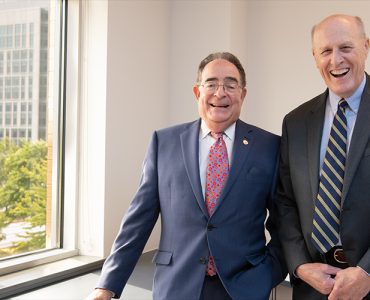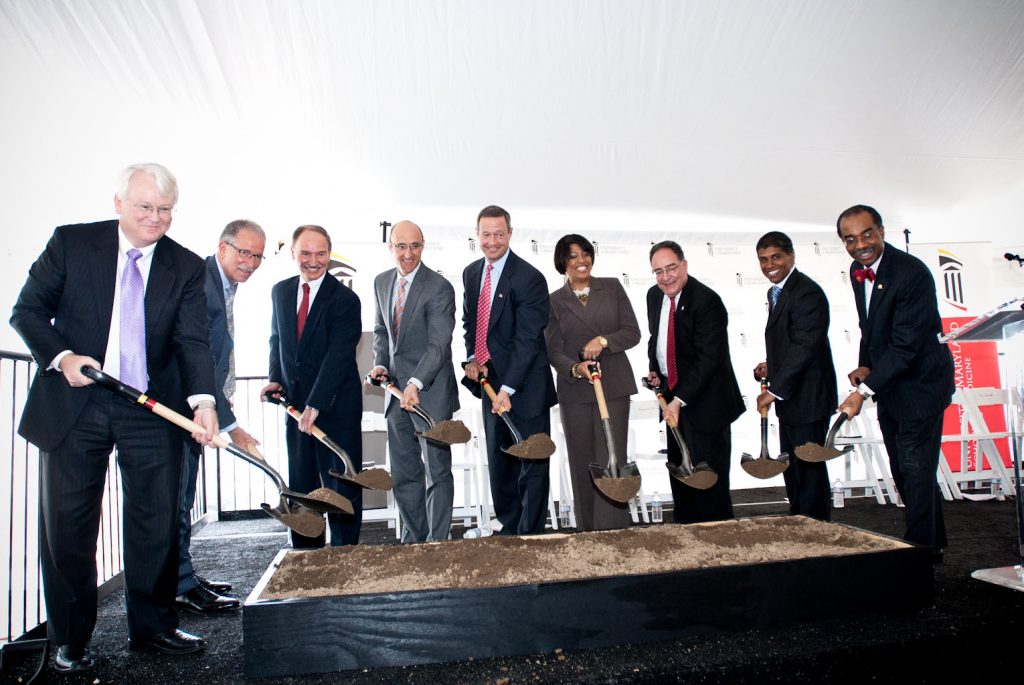
The University of Maryland, Baltimore (UMB) has seen many changes since Jay A. Perman, MD, returned as president in 2010 until now. Perman became the University System of Maryland chancellor in January 2020, but the impact he made at UMB is still felt. Here are just a few of those changes:
BioPark
THEN: The University of Maryland BioPark, created with the vision of Perman’s predecessor, David J. Ramsay, DM, DPhil, was 5 years old in 2010. Twenty-two tenants populated two large buildings on fewer than 5 acres west of Martin Luther King (MLK) Jr. Boulevard. Four new biotech startups had just moved in and the BioInnovation Center was full.
A medical technology training program was funded by a $1.4 million federal grant. A part-time Master of Business Administration program offered by the University of Maryland, College Park’s (UMCP) Robert H. Smith School of Business kept the BioPark bustling at night. The Baltimore City Community College Life Sciences Institute was another reason Perman called the BioPark “a testimony to partnering.” The Maryland Forensic Medical Center, costing $54 million including equipment, opened in September 2010, the nation’s most modern medical building of its kind.
NOW: The BioPark today is Baltimore’s biggest biotechnology cluster and a thriving entrepreneurial community. The 14-acre park is home to more than 40 health science companies that employ over 1,000 people working in areas such as oncology, autism, cardiovascular disease, and vaccine and drug development. The 110,000-square-foot Maryland Proton Treatment Center, the first of its kind in the region, opened in 2016, treating thousands of cancer patients.
The global Association of University Research Parks named the BioPark its Outstanding Research Park of 2017, noting it has “generated over $400 million in capital investment.” A 10-story, 300,000-square-foot tower, called 4MLK, is planned at the corner of Baltimore Street and MLK Boulevard that will double the BioPark’s tenant space. The groundbreaking for this new facility took place this fall.
MPower
THEN: In March 2012, an innovative, structured collaboration between UMB and UMCP was formed to connect their world-class strengths in research, technology, and education. Known as MPowering the State or simply MPower, the action was met with early skepticism. “More than a few of my colleagues rolled their eyes and scoffed, ‘Nothing of substance will come from this,’” Perman said in his March 2012 President’s Message.
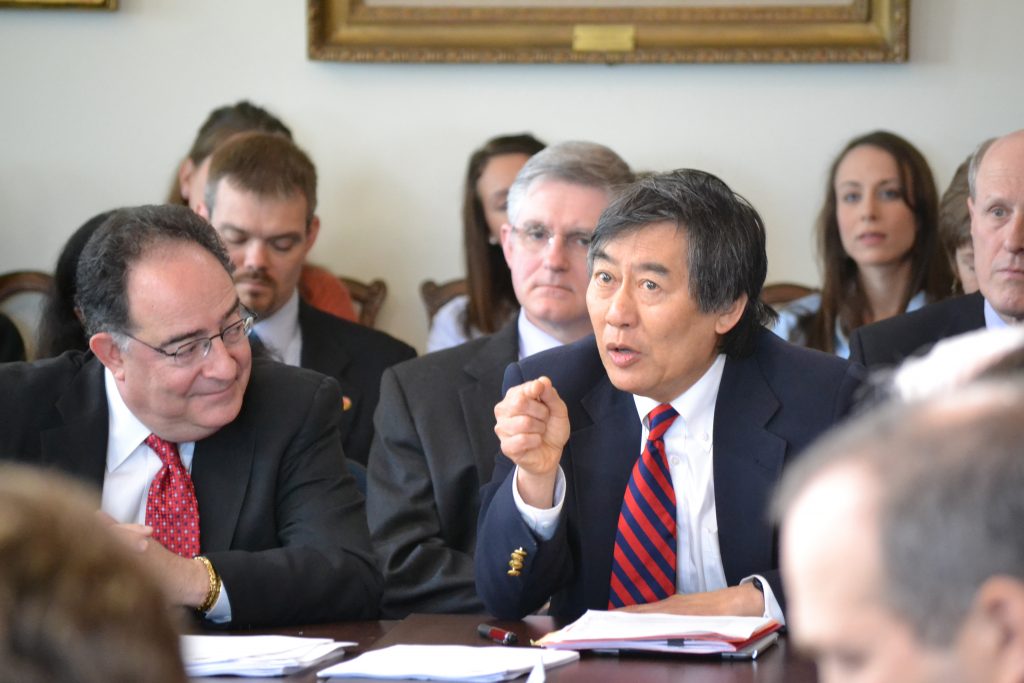
Instead, MPower quickly moved to establish UM Ventures, taking discoveries and innovations from campus laboratories to the marketplace; combined UMB’s educational programs in health, law, and human services with College Park’s STEM, business, and social sciences programs at the joint Institute for Bioscience and Biotechnology Research; formed a new Health-Related Informatics Center; and developed educational offerings through which UMCP undergraduates engaged in research led by top UMB faculty, and UMB graduate students learned with top UMCP faculty. Formalized by legislation in 2016, MPower reported five startups and 28 licenses in Fiscal Year (FY) 2011.
NOW: In FY21, UM Ventures totaled 489 potential inventions from faculty with 66 licensed to companies, generating more than $4 million in licensing revenue to UMB and UMCP. Seventeen new startups brought MPower’s total to 133 since 2011. Eight professors, four from each university, were chosen as the inaugural MPower Professors in 2021. This award, which recognizes, incentivizes, and fosters faculty collaborations, attracted 40 nominations. The two universities combined their research offices. Gregory Ball, PhD, is now the vice president for research for both universities. As a joint entity, they attracted $1.3 billion in federal and local research grants in 2021 and ranked 10th among public universities in research and development spending by the National Science Foundation.
Student Demographics
THEN: In 2010, there were 6,349 students at UMB, 29 percent male, 71 percent female, and 36 percent minorities including 15 percent African American and 14 percent Asian. The focus was more siloed, with students learning from faculty from their own schools. Some interdisciplinary work was beginning to emerge. In addition to Perman’s President’s Clinic, the School of Nursing’s Office of Global Health had a strong partnership with the School of Medicine’s Institute of Human Virology. A summer 2010 trip to Malawi in central Africa was an eye-opening experience for five students from the UMB law, medical, nursing, pharmacy, and social work schools. “We learned so much about each other’s professions,” said a participant.
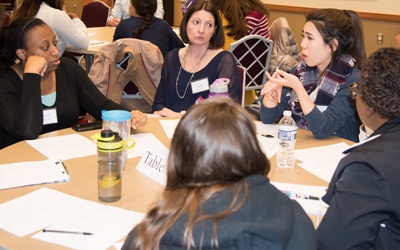
NOW: In 2022, there are 7,244 students at UMB, 27 percent male, 73 percent female, and 45 percent minorities including 18 percent African American and 15 percent Asian. Interprofessional education (IPE) rules, with a Center for IPE, launched at Perman’s urging in 2013, overseeing activities like the 10th annual IPE Day in April for students from all seven UMB schools plus some from College Park. White Paper projects tackling issues of the day also draw students from each UMB school. Students advocated for an Intercultural Center, which opened in 2020, “providing a space where all individuals feel valued, recognized, and affirmed.” A recent campus climate survey for diversity and inclusion found 2 percent of UMB students identify as transgender, 16 percent as LGBTQI+, 17 percent are parents, and 27 percent identified as having mental health conditions. Several studies finding a high rate of food insecurity among students led to the September 2021 opening of the UMB Food Pantry, which allows students to pick out free items such as oats and grains; soups, beans, and proteins; and canned fruits and vegetables.
The Universities at Shady Grove
THEN: The Universities at Shady Grove (USG) began in 1992 as part of the University of Maryland University College. Located in Rockville, Md., USG is a partner campus of nine Maryland public universities. UMB’s relationship with USG began with its School of Nursing (SON) and School of Social Work (SSW). By 2010, its School of Pharmacy (SOP) had 151 students there with 264 from SON and 68 from SSW. In his inaugural address, Perman mentioned Shady Grove and the Institute for Biotechnology and Bioscience Research there saying, “Shady Grove is emblematic of our many other opportunities with sister institutions in the University System of Maryland. … We must reach out to each other to create new knowledge and improve the human condition through collaboration.”

NOW: Today there are 463 SON students (including 76 in Doctor of Nursing Practice), nine dental hygiene students from the School of Dentistry, and 179 SSW students at Shady Grove. SOP has had perhaps the largest growth with 30 MS in Pharmaceutical Sciences students and 451 MS in Cannabis Science and Therapeutics students, the first such program in the country. “The collaboration between UMB and USG has truly been a win-win situation for our pharmacy students and faculty,” said Heather Congdon, PharmD, BCPS, CDE, FNAP, former assistant dean for SOP at Shady Grove.
University Facilities
THEN: In 2010, UMB was made up of 54 buildings, of which 32 were for academic purposes and 22 were for alternative support purposes. The School of Pharmacy opened the doors to the seven-story, 112,000-square-foot Pharmacy Hall addition in August 2010. A light-filled, three-story atrium is one of its features. Several blocks away, a new state Forensic Medical Center, the biggest in the country, opened in September 2010.
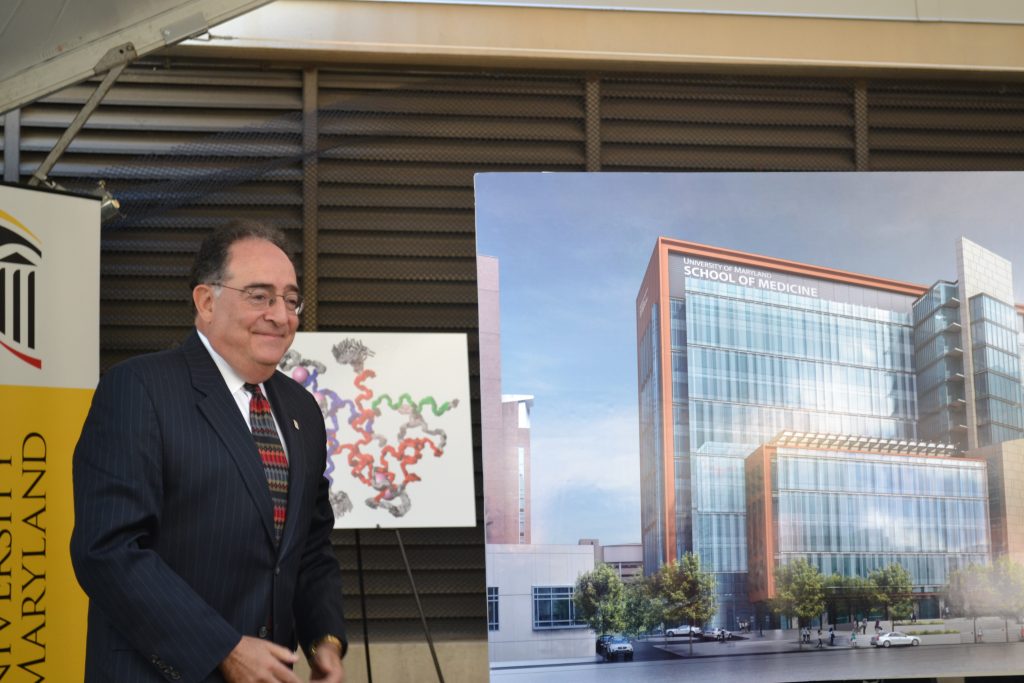
NOW: Today, UMB consists of 55 buildings, 33 of which are academic structures, 21 are support buildings, and one is a community resource. Two buildings were demolished, Harris-Hayden Hall in 2014 and Walter P. Carter Center in 2017. Among the three recent UMB physical plant additions are Health Sciences Research Facility III, at 429,000 square feet the largest biomedical research facility in the University System of Maryland, which was dedicated in October 2018, and the enlarged Community Engagement Center, which opened in 2020 at 16. S. Poppleton St. and is seven times the size of its predecessor. The General Research Building, built in 1967 to serve the state medical examiner, was repurposed for academic/research use in 2014.



